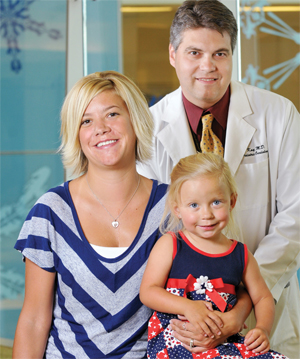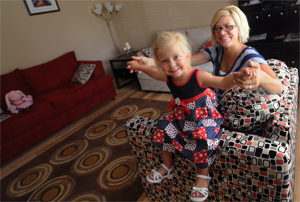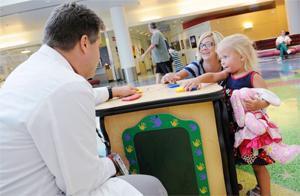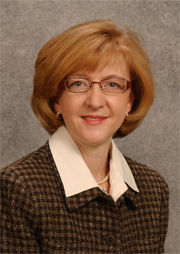Transitions
How Do You Care for Children Who Survive Congenital Illnesses?

Dan Meyers
(October 2011) When she was two months old, Jessica Stratman-Rush’s parents brought her to Children’s Hospital Colorado. Her hands and feet were blue.
The problem was her heart. She was diagnosed with two rare conditions: a hypoplastic left ventricle and a double outlet right ventricle. Both can cause blue skin, called cyanosis.
That was 28 years ago. Good timing, according to her cardiologist, Joseph Kay, MD.
“Jessica, if she’d been born before the 1970s, would have died,” Kay says.
 Instead, she was in the first generation of patients to receive surgery (a Fontan procedure) for her conditions. Today, she’s a snowboarder who went skydiving the day before she met her husband. Although her conditions can make pregnancy difficult, she is a mom whose 3-year-old daughter Daisy induces another cardiac condition, this one welcome.
Instead, she was in the first generation of patients to receive surgery (a Fontan procedure) for her conditions. Today, she’s a snowboarder who went skydiving the day before she met her husband. Although her conditions can make pregnancy difficult, she is a mom whose 3-year-old daughter Daisy induces another cardiac condition, this one welcome.
“She melts my heart.”
“Sometimes I feel nervous,” Stratman-Rush says of her medical situation. “But I have faith that God is on my side and I am confident in the care I’m getting.”
Advances in medical care allow children—like Stratman-Rush not so long ago—to survive congenital illnesses in increasing numbers. There are now more adults than children with congenital heart disease. With cancer, cystic fibrosis, sickle cell disease, Down syndrome, spina bifida
But that also means health care providers and insurers have a new pool of patients and problems.
“The fact that children with these medical issues are surviving much longer is a wonderful challenge to have, and it is a challenge because children’s hospitals and adult general hospitals have different ways of organizing their programs,” says Richard D. Krugman, MD, a pediatrician and the dean of the University of Colorado School of Medicine, who launched a discussion on the topic in February involving the key players at the Anschutz Medical Campus.
“With Children’s
The issue of how to transition patients to adult care has
“The recognition of the chasm between pediatric and adult care has grown rapidly in the last five or six years,” says Carl Cooley, MD, a New Hampshire pediatrician who heads the National Health Care Transition Center. “People are looking for tools, solutions
- Some patients simply drop off the charts when they leave pediatric care, and therefore are more likely to develop secondary problems or require urgent care.
- Pediatricians and other doctors are starting to see conditions their training may not have covered.
- As they get older, some of these former pediatric patients lack health insurance.
They may have disqualifying
 “Unfortunately, the advances of medical science have not been matched by advances in the organization, financing
“Unfortunately, the advances of medical science have not been matched by advances in the organization, financing
The University of Colorado School of Medicine, sitting on a campus with University of Colorado Hospital and Children’s Hospital Colorado, may be well positioned to take action.
The meeting called by Krugman in February has launched lots of conversations, according to Stephen Daniels, MD, chairman of the medical school’s Department of Pediatrics.
“There was general agreement that transition of care is a problem, and agreement that, given our new campus’ configuration, we should be in a position to solve or improve those transitions,” Daniels, a professor of pediatrics, says.
Daniels adds that success in this realm will help prepare the hospitals and medical school for the emphasis by health care reform funding on efficiency and quality. “One of the things that is really top of mind is creating a better pediatric health care system where care is more coordinated, evidencebased,delivered in a family-centered way and provides highest value. I think it is that work that will prepare us to survive in whatever the system looks like.”
There already are examples of cross-campus collaboration so that patients are continuously cared for as they age out of a pure pediatric setting. One is the Thriving After Cancer Treatment is Complete (TACTIC) clinic.
 Another is the Adult Congenital Heart Disease Program, which Kay directs.
Another is the Adult Congenital Heart Disease Program, which Kay directs.
Through the adult program, Kay continues the care he began with Stratman-Rush at Children’s Colorado. She moved out of pediatric care when she was 23.
“I was glad I got to keep the same doctor,” she says.
The situation is rewarding for Kay, too. “You get attached, you’ve seen them grow,” he says. “You get to know the family. You get invited to their graduations, you see their milestones. I can see them as children, as adolescents and then I bring them to University of Colorado Hospital and see them in the adult world.”
Kay’s reach is generational as well. One of his newer patients is Daisy Rush, Jessica’s heart-melting daughter, who has the condition tetralogy of Fallot.
The key to continuity of care, Kay says, is to link the two hospitals in decision-making. Doctors, and sometimes surgical leaders, huddle and figure out where the hospitals’ strengths lie and what the patients need, Kay says.
“To do this at just one of the two, I feel, would be a failure,” Kay says. “This needs to be a joint effort. It’s sometimes been a roller coaster but I hope over time there will be fewer peaks and valleys and even more cooperation.”
 For a medical school, one of the fundamental questions becomes how to teach about this rapidly evolving realm. It comes up in some coursework, such as the digestive, endocrine and metabolic systems block. Preceptors may help train students in
For a medical school, one of the fundamental questions becomes how to teach about this rapidly evolving realm. It comes up in some coursework, such as the digestive, endocrine and metabolic systems block. Preceptors may help train students in
And once a month, Laura Pickler, MD, through the JFK Partners program at Children’s Colorado, holds seminars for students interested in disabilities across the lifespan. Speakers include caregivers, parents
Pickler, an assistant professor in family medicine, pediatrics and otolaryngology, also works with state organizations and national organizations that promote the medical home approach, including continuity of care.
“We have had lots of
Related Stories